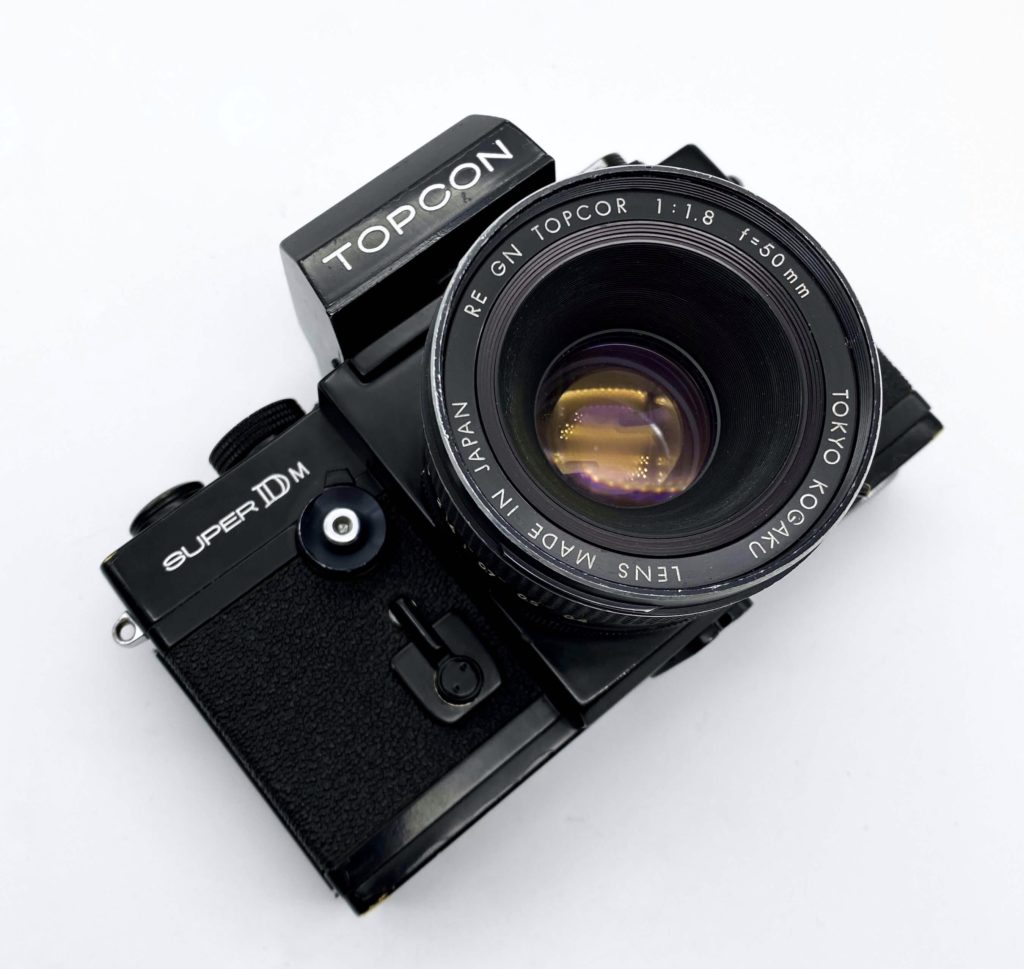
A brief history
The Topcon Super Dm is a 35mm SLR made by Tokyo Kogaku. Topcon isn't a well known company, unlike Canon, Nikon, Olympus or Minolta, who were the giants of that era.
This was mostly because Topcon ceased production in 1980. This proved to be poor timing, as the film camera industry was on the brink of the amateur photographer boom.
Nevertheless, Topcon manufactured excellent cameras. They were mainly intended for professionals and 'prosumers' (between professional and consumer level) and the quality can be felt when handling their cameras.
Design and handling

The design is very sixties: a big metal brick that clicks and clacks. That is because Topcon's camera design changed very little since its first model, released in 1963.
The camera is heavy but extremely well built. It could easily be used to drive nails into a wall without leaving a dent in the body.
The Topcon Super D was famously chosen as the combat camera by the US Navy and US Airforce. It won against the Nikon F and several other Japanese and German cameras due to its more robust construction and better ergonomics.
Back to the design. Topcons use a lens mount based on the Exacta mount. As a result, most Exacta lenses are compatible with the Topcon. which gives access to a wide range of quality glass. Unfortunately Topcor lenses aren't backwards compatible, as the flanges differ slightly from the Exacta mount.
Topcon made many smart design choices in their cameras. When looking through the viewfinder, you can see the lightmeter and a little viewing window that shows your selected aperture. This allows you to change the aperture without having to remove your eye from the viewfinder.
The viewfinder is removable, allowing you to use the camera with a waist-level finder. This makes it perfect for #cameraporn photos on Intragram.

The film advances in a continuous movement of 180 °. It is fluid, very satisfying and comes back
quickly in place. The speed selector is on the top and is of classic design. Speeds range from 1s and B to 1/1000. The lightmeter covers a range of 25 to 1600 ISO.
The shutter release is on the front panel, unlike most other SLRs. It is surprisingly practical, though it does take a minute to get used to it. It is naturally positioned under your middle finger, allowing for a little more stability when pressed. This is particularly useful when using low speeds handheld. It also has a small lock to prevent accidental exposure when the shutter is cocked. The camera also features a depth-of-field preview lever, a lever for mirror lock-up and a self-timer.
To open the film door you must press a button on the bottom of the device. It's a system that seems rather risky, as its easy to press by accident. The bottom plate also houses the battery compartment and the on / off switch for the lightmeter. Like most cameras, the rewind button and motor drive gear are also found on the bottom plate.

Operation
In terms of operation the Topcon Super Dm is a fairly classic film camera. It is completely mechanical, meaning that no batteries are needed for the shutter operation. This also means that there is no automatic or priority mode. Camera use is fully manual.
The batteries are used to activate the lightmeter. It requires a 1.3v mercury for optimal functionality. Mercury batteries are no longer made, though it is possible to adapt an SR44 1.5v battery.
Due to the quarantine regulations I had to test the camera in my beautiful outdoor studio. It's an extremely high-tech setup: a white bed sheet hanging in my garden.
The Topcon is fairly easy to use and the controls are positioned quite naturally. The focusing screen is not very big compared to newer SLRs like the Olympus OM-1 or Minolta X700. However it is surprisingly bright, at least brighter than the Nikon F.
The small window in the viewfinder proved to be very useful, allowing you to see the current aperture. This means you won't miss the shot because you're checking your settings.
The Super Dm is a bit heavy for a 35mm camera but it contributes to the good grip, provided you don't have very small hands.

The things I liked the most about the Topcon were the details. It's a big camera - a real brick, but there are lots of little things that make it a little more 'special'. The way the lock on the shutter clicks perfectly in place, the on/off switch for the meter, the ease with which the prism can be removed (a single button that isn't difficult to press, like Nikon), the long mirror lock-up lever and the way don’t rewind lever comes out automatically of the camera when rewinding the film.
I used a 50mm f1.8 RE GN Topcor lens. This is the lens with which the camera was most often sold at the time. It seems to have a cult following on some internet forums. It is quite sharp overall and renders pleasant contrast, I was satisfied with the results. I now regret selling all my Exacta lenses before having tested this camera, I would have liked to use it with older lenses.
Conclusion
In conclusion I think the Topcon Super Dm is a nice device for someone who wants something a little different. It’s a professional, completely mechanical, device that, if you take care of it, will surely outlive you.







Pictures have been shot on Ilford HP5 and Kodak Gold 200. Please pardon the scratches on the black and white film. It was my first try with my new bulk-loader and the dark-box is really dark.

